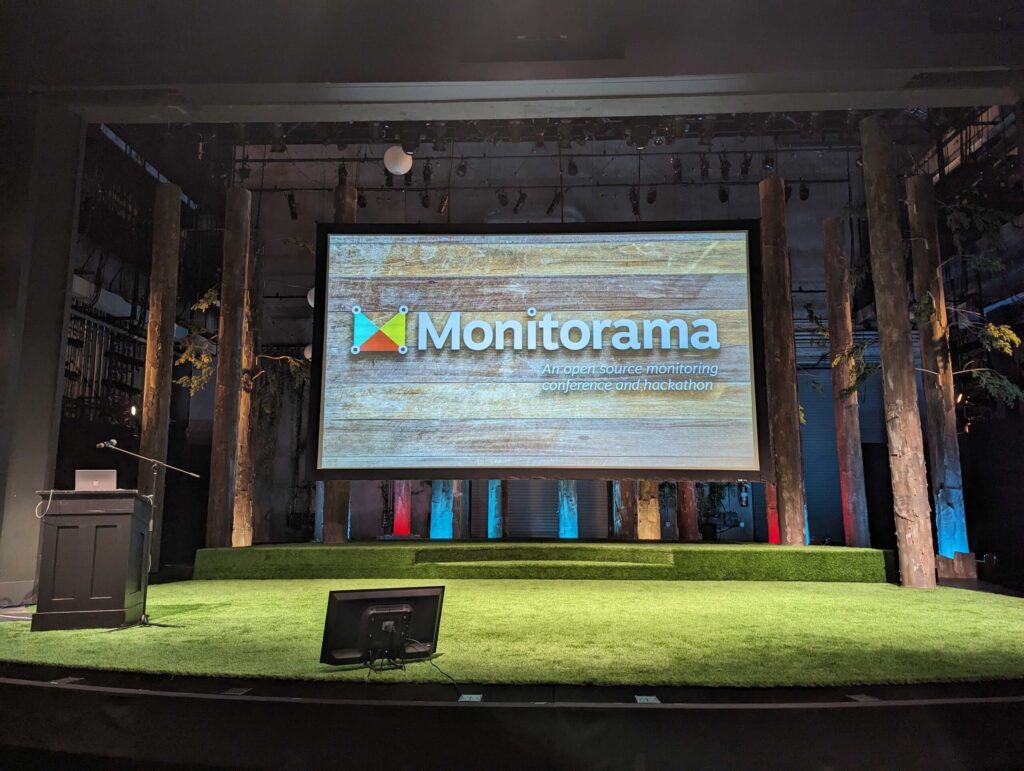Last week, from June 26-28, hundreds of monitoring and observability practitioners visited Portland for Monitorama 2023. This conference focuses on the latest technology and gives folks the chance to reconnect with familiar faces and really take the time to delve into all possible conversations around observability.
1. The industry is still defining observability
Many Monitorama attendees are already quite familiar (and passionate) about the benefits that observability and monitoring can bring to a department or an organization. But there’s still a lot of instances where the definitions for “observability” differ depending on who you ask.
“[A] big question for us is ‘what is the minimum viable set of attributes for an atomic unit of observability?’ One person may be solving a technical issue, but there is [often] valuable information for the rest of the organization,” explained Timothy Mahoney, Senior System Engineer, Ingka Group Digital (IKEA), during his presentation What we talk about when we talk about observability frameworks.
Still, even with a variety of definitions, it’s clear that the goals for observability are fairly aligned across organizations; ultimately, engineers want tools to be able to maintain system reliability, provide relevant and actionable data, control data growth and costs, and reduce mean time to remediate (MTTR).
On Chronosphere’s part, we’re focused on helping organizations with cloud native environments get the most out of investments in modern infrastructure and applications. We feel cloud native observability focuses on business outcomes — knowing, triaging, and understanding issues — so teams improve MTTR and mean time to detect (MTTD) while delivering a better experience to their customers, without burning out engineers.
There was also plenty of talk of how observability can benefit an organization as a whole, but it requires a lot of effort and evangelism to do observability right. In order to make an effective business case for observability, it goes beyond just having observability tools in place. Just like DevOps, adopting cloud native observability requires an investment in processes and culture to work across teams in an organization.
2. OTel and the push towards more standardization
Multiple presentations this year mentioned using OpenTelemetry (OTel) as a way to standardize data collection. As observability continues to mature, it’s clear that the industry needs standards to help with – and support – open source tools.
Broader industry standards such as OTel help bring observability and monitoring data out of its silo and make it easier for engineers to effectively use all the collected telemetry data. Especially as a lot of observability platforms rely on open source, having a vendor-neutral API for telemetry collection helps engineers avoid vendor lock-in or require another software to collect data across different tech stacks.
“Metrics, logs, and traces simply do not provide enough context. We need to connect this data to the bigger picture,” said Richard Benwell, Founder and CEO of SquaredUp, in his talk, Connecting the dots with OTel semantic conventions.
In terms of OTel, promoting adoption and necessary semantic convention will help standardize data, make it easier to use, and increase overall connectedness, he adds.
3. Cost is still a very, very big concern for companies
Cost was not only a big conversation topic throughout the presentations – but something we chatted a lot about at our booth. Given the uncertain economic climate and market pressures, many organizations are looking to see how they can use observability and monitoring to avoid costly outages, maintain customer satisfaction, and improve their bottom line without overpaying for a solution that doesn’t provide value.
Compared to past years, companies must now focus on efficiency in order to grow. But it can take a lot of time for engineers and executives to figure out how much observability is actually going to cost – and ways to avoid getting a surprise bill at the end of the quarter.
“Consider cost before the first line of code is written … It’s [also] important to realize that watching costs often has a cost,” said Emily Nakashima, VP of Engineering at Honeycomb, as part of her talk, Building a real-time cloud cost management program with observability.
Most observability engineers don’t need to become finance experts. But it can help to continually see what metrics and services generate the highest costs within a system and if they’re necessary for operation. In being able to get this data – with a tool such as our Metrics Usage Analyzer – it reduces the chance a surprise metric or service will tack on a sizable charge to any observability bill.
4. Alerts, alerts, alerts
Alert fatigue and developer productivity is a constant discussion in the observability space – and Monitorama was no exception. Several presentations focused on the types of tools engineers can use to reduce alert fatigue, or talked about the theory behind alerts themselves.
Certain organizations may think that alert fatigue is something that just requires more tools. But that isn’t always the case. To make sure the data gets in the right hands at the right time, it’s often about the quality or usefulness of tools.
“The question is not, ‘how many tools do we have?’ but ‘are those tools useful and effective?’” asked Paige Cruz, Senior Developer Advocate at Chronosphere, during her presentation, Pushing observability uphill: The single “pain” of glass.
Beyond the tools, engineers must ensure their alerts can provide enough context to be helpful. Often, alerts can be either too low-level, not include enough information, or go off too often.
During his presentation, Thinking critically about alerting, Dan Ravenstone, Staff Engineer at TopHat, explained well-planned alerts have:
- A run book/plan of action
- A defined priority level
- A corresponding dashboard
- Properly assigned labels and tags (such as owner, service, environment)
- A correctly defined route (if urgent, goes to on call staff)
With this information already built into an alert, and practicing alert hygiene, engineers can reduce the amount of unnecessary alerts.
Connecting folks to Chronosphere
We spent plenty of time chatting – and demoing – at our sponsor booth about cloud native observability and what makes Chronosphere right for organizations looking at observability tools.
With Monitorama’s attendees being the most savvy observability practitioners, we were really able to dig into the details of our product and demonstrate to engineers how Chronosphere reduces cost, customizes metrics collection, and makes engineers more productive. To support these initiatives, we announced our new Observability Data Optimization Cycle — a framework to deliver the best possible observability outcomes at scale while keeping costs under control.
We packed the three-day event with swag giveaways, a “Level Up Your Observability” scavenger hunt, and yummy sugar cookies.
The “Cheers to Observability” event at the Multnomah Whiskey Library was a packed event. Our mystery tasting gave attendees the chance to try some selections from our own Bourbon Steward, Alex Baptista. If you attended, which one was your favorite?
- Wyoming Whiskey Co – Double Cask Bourbon
- Westward – American Single Malt
- Jack Daniels Single Barrel – Cask Strength
- Kavalan Concertmaster – Port Cask Finish
Monitorama 2023 was a busy, engaging few days to chat about the latest in observability and monitoring for engineers and business stakeholders. Not only did the presentations provide a lot of insight, but we confirmed that there’s a lot of interest in cloud native observability – and we’re right here to help organizations maximize their investment.
Until next year, Portland!
Interested in how cloud native observability can help keep your systems reliable? Contact us for a demo today.





